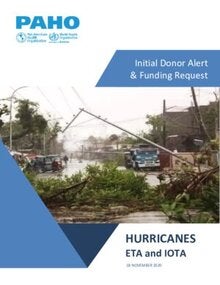Initial Donor Alert & Funding Request - Hurricanes Eta and Iota

|
On November 3, Hurricane Eta made landfall along Nicaragua’s Caribbean coast (26km south of Bilwi) as a Category 4 storm with maximum sustained winds near 140mph (220 km/h) and continued moving towards the west near 6mph (9kmh/h). On 4 November 2020, the system rapidly weakened to a tropical storm, but nonetheless caused extensive damage in Honduras, Guatemala, Costa Rica, Belize, El Salvador, Panama, Colombia, and Jamaica. Two weeks later, on November 16, Hurricane Iota, a category 5 storm, made landfall in the Colombian archipelago of San Andres, Providencia, and Santa Catalina. It moved along the northeastern coast of Nicaragua near the town of Haulover with sustained winds near 155 mph (250 km/h). On November 17, Iota weakened to a Tropical Storm, moving into southern Honduras and Guatemala. Guatemala, Honduras, and Nicaragua, which were located in the direct path of both hydrometeorological events, are the most affected countries. Hurricane Eta and Iota left a path of devastation in Central America, with more than 6.5 million persons directly affected. Approximately 441,000 have been evacuated and suffered significant dwelling and livelihoods losses. Over 125 health facilities across all three countries are reporting infrastructural damage further reducing the capacities of the national health systems already overstretched by the COVID-19 pandemic. Reduced access to drinking water, loss of adequate sanitation, and power outages have also been reported. Conditions in some shelters remain precarious due to inadequate infrastructure, sanitation, and limited access to safe water, all critical to mitigate the risk of COVID-19 infections and other communicable diseases endemic in the affected countries. An estimated US $9,900,000 is required to support urgent humanitarian actions aimed at ensuring availability of critical healthcare, adequate WASH conditions, increased epidemiological surveillance, and vector control in highly vulnerable areas along the Central American Caribbean Coast. |
